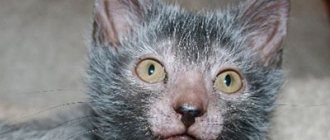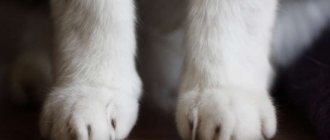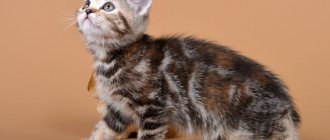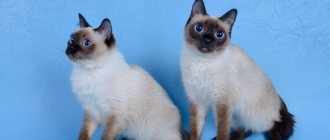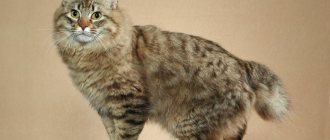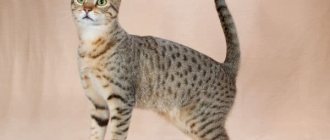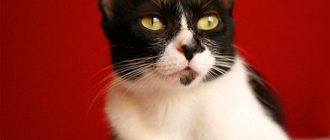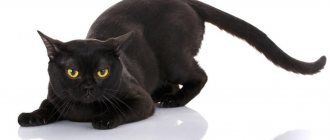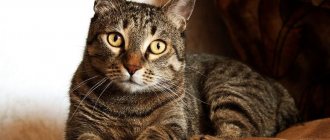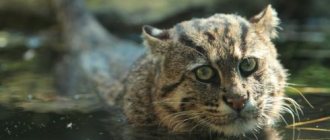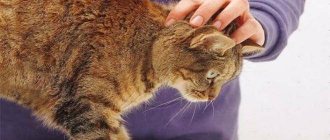With their appearance, Lyka cats created a sensation in the world of felinology. They are not the result of a genetic experiment, as one might think. Lykoi appeared as a result of natural mutations of a short-haired cat. In character and habits, they are no different from ordinary domestic purrs. Breeders claim that, despite its external resemblance to werewolves, the cat will definitely not begin to turn into a full moon.
Origin story
Lykoi cats are not the result of a crazy experiment; they are the result of a natural mutation. In 2010, in Virginia, Patty Thomas discovered that his yard shorthair cat had given birth to unusual kittens; by the age of one month, they began to develop bald patches through which pink skin was visible. Tedious trips to veterinarians followed, taking various tests and searching for health problems. Meanwhile, the kittens grew up and developed completely normally. The specialists’ verdict was made - they are absolutely healthy. Thomas later became one of the founders of the breed, who gave it its name.
In 2011, Johnny Gobble in Tennessee discovered a second pair of animals with an identical mutation. Kittens from two litters were the basis of a program to increase the Lykoei gene pool, which also included ordinary black shorthair cats. During its formation and development, the breed underwent more DNA tests for various diseases than any other. According to information, similar mutations have occurred before, but no one thought about their preservation.
The name of the breed Lykoi was not chosen by chance. Translated from Greek, lykos means wolf or werewolf.
In 2011, the first kitten from a pair of Lykoi appeared. The breed began to develop at a rapid pace; after a few years, nurseries were opened in other States: Missouri, South Carolina, Texas, California. Werecats began to travel to different countries and continents. In 2012, they were accepted into the TICA registry of new breeds, and in 2021 they received champion status and the right to exhibit.
The creepy appearance not only does not interfere with these creatures, it is what contributes to the growth in popularity and demand for kittens, which is hundreds of times higher than the supply.
Video about cats of the Lykoi breed:
Characteristics of the Likoy breed
global $ads_google;
//data-ad-slot=”2475549904″ $ads_google = empty($ads_google) ? false : true; ?> if ($ads_google == false) {?> $ads_google = true; ?> } ?> Representatives of the Likoy breed are distinguished not only by their unusual appearance, but also by their unique character. The transformation from an affectionate and exemplary cat can happen literally before your eyes. As soon as a stranger appears in the house, the werewolf cat becomes an ardent defender of its space. The care of the owner and family members is a priority for her.
Such wild notes of character can appear in a Lykoi cat in relation to other animals. Even large dogs are not an obstacle for them that they are afraid of. That is why everyone who dreams of a cat with a mythical appearance and has other four-legged animals in the house should think about the advisability of such a neighborhood.
But, despite this character trait, the Lykoi cat is very kind and devoted to its owners. Werewolf cats are not afraid of loneliness either. If, due to life circumstances, the owner needs to leave the house, his pet will find something to his liking. Therefore, for busy people, Lykoi is a great find.
Another positive feature of the Lykoi cat is its sharp intelligence. Even when playing with intellectual toys, these pets show intelligence and resourcefulness. They have this level of development by nature - true hunters must be not only dexterous, but also smart. It is because of their hunting nature that it is recommended to walk half-naked cats on a leash. This is a guarantee that the pet will not run away in the heat of the hunt.
Appearance
It's amazing how quickly a breed with such a shocking appearance became popular among cat lovers all over the world. Lykoi are partially hairless cats with a unique coloration that is a combination of black and white hairs. There is a noticeable difference between cats and cats, it is visible even in the photo. Males are noticeably larger and more massive, their weight usually ranges from 4.5-6 kg, while cats weigh 2-3.5 kg.
The Lykoei mutation is individual, which is confirmed by comparative DNA analysis with sphinxes and Devon rexes. The baldness gene in Lykoi is recessive. Another DNA analysis showed that their color is not a tabby variety.
The head is medium-sized, wedge-shaped. The stop is not expressed. The nose is wide, slightly humped. The neck is long. The ears are wide at the base, high, slightly pointed. The distance between the ears is not large. The eyes are round, expressive, color: yellow, gray, green or blue. The hairless muzzle gave the Lykoi the amazing, easily recognizable appearance of a werecat. The body is compact, not too powerful, but not thin either, athletic, slightly elongated and flexible with a wide chest. Legs of medium length, medium sized tail.
Bald areas are located around the eyes, on the virris pads, on the chin and on the bridge of the nose. Almost all representatives of the breed have sparse hair on the front and hind legs, chest and belly.
The coat of the Lykoi is very soft, short, and sparse. Consists only of guard hair, the undercoat is completely absent. The degree of baldness in cats varies from person to person; some may be practically naked, while others are distinguished only by their “moth-eaten” muzzle. Another distinctive feature is the original roan color or roan.
Among cats, it is found only in Lykoeis. The skin is pink and tans quickly in the sun, like other hairless breeds. The most popular color is black and white, a pronounced roan, but cats can also have lighter coats, up to light gray, which in combination with white hairs and hairless areas makes them very light.
Character
Lykoi are very smart and inventive cats, sociable, friendly, active and playful. They will play with people with pleasure, and in hours of solitude they will entertain themselves with a toy or any other little thing that attracts attention. They easily and happily walk outside and selflessly protect the territory. This behavior is especially pronounced in cats.
At home they are curious and very energetic. rarely sleep for 20 hours at a time, prefer to be in the center of events, will explore new toys and surroundings with interest, need close contact with a person and new impressions. At the first meeting, they behave carefully, carefully getting to know any new object, person or pet to make sure there is no danger or threat. Owners note that many Lykoys like to sit in the gopher pose and actively use their front legs in play and everyday life. Lykoys demonstrate strong hunting instincts during play; on the street they happily hunt beetles and butterflies; they rarely pursue larger prey.
Content Features
Lykoi are perfectly suited for living in an apartment or in a house, they quickly adapt to new conditions, become attached to all family members, and are neat and clean. Contrary to popular belief, they are not hypoallergenic. Like other cats, they shed, the degree of shedding depends on the time of year, the amount of hair on the body and climate. The fur is very soft to the touch, the naked body is warm and velvety, and the nose, as expected, is cold and wet.
Lykoi are very friendly, so they easily get along with other pets, cats, dogs, small rodents and birds, anyone who doesn’t mind their company.
The effects of heat and cold on bare skin are more active than in coated cats. In the cold season, it is advisable for them to select clothes according to the weather, and in the summer to protect them from excess direct sunlight, which can cause burns. Given the high activity of the cat, it is advisable to install a play complex.
Care
Grooming is an important part of keeping a cat; it is not difficult since cats have little hair. For bathing, it is recommended to use a mild cat shampoo with a natural hypoallergenic base. The frequency of washing is individual in each case and depends on the skin type.
Some lykoys are washed once a month, others - once every six months.
Periodically comb the cat or remove mature hairs with a damp hand. Ears need to be cleaned regularly. A peculiarity of the breed is the accumulation of brown secretion from the sebaceous glands in the ear and near the claws, which must be carefully cleaned approximately once a week.
Nails should be trimmed regularly. Like Sphynxes, they have a brown secretion around their claws, which is rarely a sign of illness and can be easily removed.
Feeding
There are no special feeding recommendations. Like other cats, the Lykoi needs a balanced, healthy diet. Most breeders prefer wet or dry ready-made food.
Lykoyam diets are suitable for domestic cats of small and medium breeds. You should not pay attention to food below the super-premium class. If you wish, you can provide cats with complete natural nutrition, but this will be difficult, given that they are often picky eaters.
Breed standard
What gives them the appearance of werewolves is their fur. Its quantity depends on the time of year. The minimum amount of undercoat is due to a lack of follicles. For the same reason, during shedding, the fur may fall out completely. Likoy also has other features:
- The body is thin, flexible, with an elongated body and highly developed muscles.
- The paws are well developed, of medium length, with scanty hair. The hind ones are shorter than the front ones. The lower part of the paws is bare, the pads are oval, the toes are long and webbed.
- Weight – 4-6 kilograms.
- The tail is long, tapering towards the tip, but not longer than the body. Covered with coarse, short hair.
- The neck is normal, not muscular.
- The head is wedge-shaped, with rounded edges, and a slightly elongated rounded forehead. The pads under the mustache are fleshy and have soft outlines. The nose is slightly rounded down.
- In accordance with the standard, the face of Likoi should be bald, with a well-developed chin. If this rule is not followed, pets at exhibitions will be disqualified.
- The ears are large, with sharp tips, widely spaced, erect. Covered with sparse hairs.
- The eyes of the cat Likoy are large, shaped like a walnut, slanted upward, without a frame of fur. The look is piercing, open. Usually the iris of the eyes is golden or green, blue is extremely rare.
The coat of the Likoi cat is the main distinguishing feature of the breed. It is rare, soft, and can be short or medium length. The amount of wool varies depending on the season. There is little undercoat. The fur of the Likoi cat is almost the same as that of an opossum.
The standard color is roan (black with silver). The hair is light gray or white at the base and black at the ends. Kittens may have other colors. They are allowed according to breed standards. However, such Likoy cats are not allowed into high-level exhibitions.
Folded skin is sensitive to heat. If Likoi sunbathes in the sun for several hours, the skin becomes covered with pigment spots. When fully tanned, it turns black. The same effect is observed if Likoi sleeps on a hot radiator. With daily heat exposure, the skin becomes pink.
Kittens are not much different from adult pets, they look just as clumsy and “ragged.” They are born completely covered with black fur (with a bare muzzle). After the first molt, cats develop bald spots and white hairs grow. Adult males are much larger than females.
Non-standard cats are those without a roan color, without a bald mask on the face, with defective tails, and completely covered with hair. Its thickness is also considered a disadvantage. The defects of the breed are finger mutations, cowardice or aggression, blindness, strabismus, and in cats, testes that are not descended into the scrotum.
Health and life expectancy
The experience of breeders and multiple tests have shown that in the breed at this stage the hairlessness gene is not associated with any pathologies or hereditary diseases. Lykoys can have any feline health problems, but, as a rule, they are caused by improper care, maintenance or nutrition.
Likoi were tested for selective diseases of the skin, heart, thyroid gland, blood, some infectious diseases, as well as hereditary diseases of the kidneys, liver and digestive tract common among cats. All results are negative, which suggests good health and good genetics.
Lykoi cats need the same vaccinations as regular domestic cats, as well as regular treatment for external and internal parasites. Use standard veterinary products. The breeders claim that they have never observed an allergic reaction to veterinary drugs, food or cosmetics.
Where to buy a Lykoi kitten
Buying a Lykoi kitten is now easier than it was in the early years of their appearance, but the number of kittens on sale is still very limited. As of 2021, there are just over 200 standard Lykoi cats registered in the world with a characteristic color and location of receding hairline, as in the photo. Nurseries can be found not only in the States, but also abroad, in particular in Russia and neighboring countries. Some companies deliver kittens with documents directly from America.
Newborn kittens differ from adults in their uniform solid color, and they do not have bald patches.
With age, more and more white hairs appear and in some places the hair begins to fall out. By 1.5 months they acquire a practically formed roan color, which remains in the future.
Price
The average price of a Lykoi kitten in the United States is $2,000. Naturally, we are talking about kittens with documents of origin from nurseries. In European countries, the price fluctuates approximately in the same range. There are only a few representatives of the breed in Russia, most of them live in one of the largest Moscow nurseries, Murmulet. The price of a Lykoi kitten in Moscow usually starts from 100,000 rubles.
The limited number of kittens and huge demand allows breeders to keep the price at the same high level as their foreign colleagues. In addition, the cost of a kitten is affected by its color; dark-colored babies usually cost more. Those wishing to buy a kitten abroad need to be careful. In America, offers have already begun to appear from scammers or “swindlers” to sell lykoi inexpensively.
Maintenance, care and cost of a cat
Likoi's appearance can be misleading about his health. But they should have this appearance, and at the same time excellent health. Geneticists have not ruled out the presence of hidden anomalies in cats, but so far no abnormalities have been identified. They are susceptible to standard diseases of the cat family.
Lykoi's care is carried out much more carefully in comparison with ordinary cats. Pets need to be bathed frequently to wash away accumulated sweat in the folds of the skin. If the cat is reluctant to accept water procedures, then they can be replaced with daily wiping with wet wipes.
Every seven days, Likoi cats need to have their ears cleaned. Check your eyes daily and trim your nails often (they grow quickly). Pets shed, sometimes shedding their fur completely. A new one grows in 12 months.
There are only 7 nurseries of the Likoi breed in the world. There are many applications for them until breeders cannot meet the demand. There are 32 individuals with the standard color. The average cost of a kitten varies from 50 to 80 thousand rubles. Since buying a purebred pet is problematic, the price can be even higher - up to 160,000 rubles. for roans and 95,000 rubles. at the blue ones.
The population of the Likoi cat breed is still small. The biological characteristics and habits of cats have not yet been fully studied. However, werewolf pets are becoming more popular.
